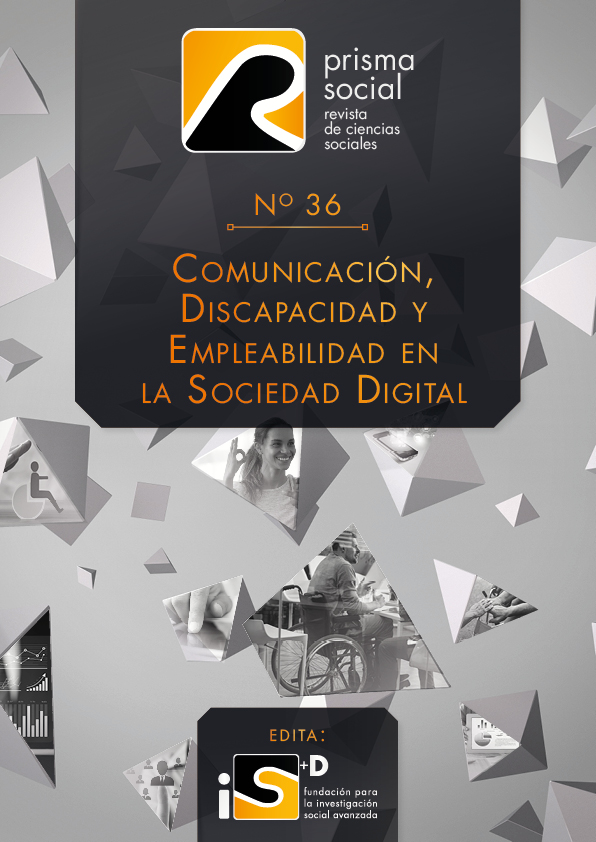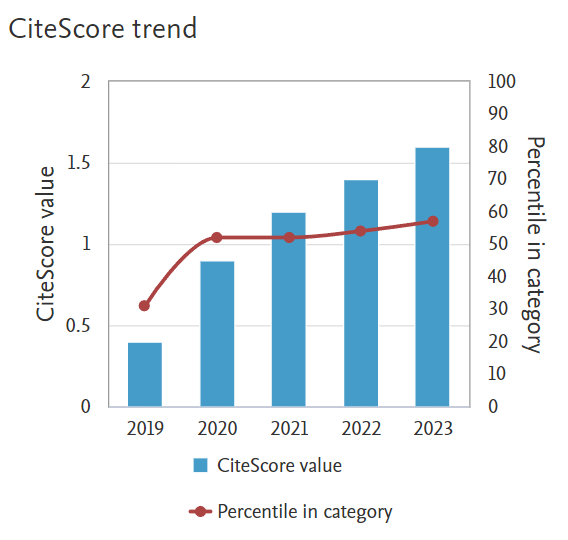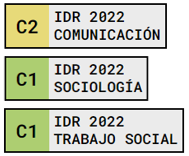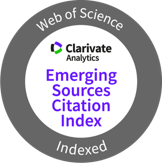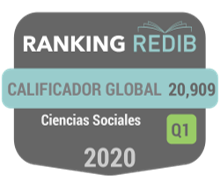Competencias emprendedoras en las personas con discapacidad
Palabras clave:
Discapacidad; Competencias; Emprendimiento; Motivación; Formación.Resumen
Mejorar la empleabilidad de las personas con discapacidad es un reto social de primera magnitud presente en programas como Europa 2020 (Observatorio Estatal, 2017) y más recientemente -aunque en sus primeros compases-, en la nueva Estrategia Española sobre Discapacidad 2021-2030 (ONCE, 2022) para la consecución de sociedades inclusivas. Las personas con discapacidad son uno de los colectivos más expuestos a situaciones de exclusión social en una sociedad digital en la que la adquisición de competencias formales y actitudinales está sometida a constante cambio.
Por ello, conocer las competencias socioemocionales que reconocen los/las emprendedores/as con discapacidad y los factores moderadores en su adquisición, se convierte en un objetivo fundamental. De acuerdo con la literatura sobre el tema, la formación/experiencia y la motivación para emprender intervienen como moderadores. Su análisis es el objetivo de este artículo.
Se ha utilizado una metodología cuantitativa basada en los resultados de la encuesta realizada a una muestra de 224 personas emprendedoras con discapacidad física, sensorial u orgánica en España. Con el fin de llegar a la comprobación de las hipótesis establecidas en la investigación, se ha realizado un análisis estadístico con el lenguaje de programación R.
Los resultados obtenidos han puesto de manifiesto la relación entre la valoración que hacen las personas con discapacidad de sus competencias y el hecho de emprender. Por otra parte, presentan una autovaloración socioemocional en clave competencial más elevada aquéllas personas que llevan a cabo el emprendimiento por oportunidad y no por necesidad.
Descargas
Citas
Allison, T.H., Davis, B.C., Short, J.C. y Webb, J.W. (2015). Crowdfunding in a prosocial microlending environment: examining the role of intrinsic versus extrinsic cues. Entrepreneur. Theory Pract., 39 (1), 53-73. https://doi: 10.1111/etap.12108
Barba-Sánchez, V. (2008). La necesidad de logro y la experiencia del emprendedor: elementos clave en el crecimiento de la nueva empresa. Revista de Contabilidad y Dirección, 5, 121-138. Recuperado de: http://accid.org/revista/documents/RCD5_castellano_121.pdf
Barba-Sánchez, V. y Atienza-Sahuquillo, C. (2017). Entrepreneurial motivation and self-employment: evidence from expectancy theory. International Entrepreneurship and Management Journal, 13, 1097-1115. https://doi.org/10.1007/s11365-017-0441-z
Bereiter, C. (2002). Education and mind in the knowledge age. Hillsdale: Lawrence Erlbaum.
Beret, P. y Dupray, A. (1998). Valorización salarial de la formación profesional continua y producción de competencias por el sistema educativo: los casos de Francia y Alemania. Revista Europea de Formación Profesional. 14, 40-51.
Billett, S. (1994). Situated learning: a workplace experience. Australian Journal of Adult and Community Education. 4 (2), 112-130. Recuperado de: https://search.informit.org/doi/abs/10.3316/ielapa.950302159
Blanck, P.D., Sandler, L.A., Schmeling, J.L., y Schartz, H.A. (2000). The Emerging Workforce of Entrepreneurs with Disabilities: Preliminary Study of Entrepreneurship in Iowa. Iowa Law Review, 85 (5), 1583-1668. Recuperado de: https://papers.ssrn.com/sol3/papers.cfm?abstract_id=382587
Brindley, C. (2005). Barriers to women achieving their entrepreneurial potential: Women and risk. Internacional. Journal of Entrepreneurial Behaviour and Research, 11 (2). 144-161. http://dx.doi.org/10.1108/13552550510590554
Brush, C. G. y Hisrich, R. D. (1988). Women entrepreneurs: strategic origins impact on growth. Frontiers of entrepreneurship research. 6, 12-25.
Burckle, M. (2000). ECI and MBTI, Hay/McBer Research Report.
Caldwell, K., Parker, S. y Renko, M. (2016). Social Entrepreneurs with Disabilities: Exploring Motivational and Attitudinal Factors. Canadian Journal of Disability Studies, 5-1, 211-244. https://doi.org/10.15353/cjds.v5i1.255
Capelli, P. (1997). Change at Work. Oxford: University Press.
Cappelli, P. y Eldor, L, (2021) Monograph Chapter, Published:11 March (2021). Contracting, engagement, and the gig economy. En J. P. Meyer y B. Schneider (Eds.), A Research Agenda for Employee Engagement in a Changing World of Work. (pp. 103–118) Monograph Chapter DOI:https://doi.org/10.4337/9781789907858.00015
Cappelli, P. (2021). The new workplace (A special report) here comes the two-tier workplace: On-site employees will get the bulk of the attention and the promotions. Wall Street Journal Retrieved from https://www.proquest.com/newspapers/new-workplace-special-report-here-comes-two-tier/docview/2561393850/se-2?accountid=17225
Carbonell, J. R., Hernandez, J. C. P. y García, F. J. L. (2014). Business creation by immigrant entrepreneurs in the valencian community. The influence of education. International Entrepreneurship and Management Journal, 10(2), 409-426. https://doi.org/10.1007/s11365-011-0211-2
Cardon, D. y Casilli, A. (2015). Qu’est-ce que le Digital Labor? Paris: Ina Editions.
Catley, S. y Hamilton, R. (1998). Small business development and gender of owner. Journal of Management Development, 17 (1), 75-82. https://doi.org/10.1108/02621719810368718
Civelli, F. (1997). New competences, new organizations in a developing world. Industrial and Commercial Training, 29 (7), 226-229. https://doi.org/10.1108/00197859710190742
Coleman, N., Hare, D.J. y Farrell, P. (2008). The use of the Social Cognitive Skills Test with children with autistic spectrum disorders. Journal of Intellectual Disabilities, 21 (1), 49-57. https://doi.org/10.1177?1744629507086608
Cooney, T. (2008). Entrepreneurs with Disabilities: Profile of a Forgotten Minority. Irish Business Journal, 4 (1), 119-129. https://doi.org/10.21427/D73B77
Dalmau, M., Llinares. M. y Sala, I. (2013) Formación universitaria e inserción laboral. Titulados españoles con discapacidad y competencias profesionalizadoras, Revista Española de Discapacidad, I (2), 95-118. http://dx.doi.org/10.5569/2340-5104.01.02.06
Davidsson, P. y Honig, B. (2003). The role of social and human capital among nascent entrepreneurs. Journal of Business Venturing, 18 (3), 301-331. https://doi.org/10.1016/S0883-9026(02)00097-6
Degryse, C. (2016). Digitalisation of the economy and its impact on labour markets. Working Paper 2016.02, European Trade Union Institute, Brussels, 86. https://doi.org/10.2139/ssrn.2730550
Delmar, F. y Davidsson, P. (2000) Where Do They Come From? Prevalence and Characteristics of Nascent Entrepreneurs. Entrepreneurship and Regional Development, 12, 1-23. Recuperado de: http://eprints.qut.edu.au
De Wolf, P., McElwee, G. y Schoorlemmer, H. (2007). The European farm entrepreneur: A comparative perspective. International Journal of Entrepreneurship and Small Business, 4(6), 679-692. Recuperado de: https://www.inderscienceonline.com/doi/abs/10.1504/IJESB.2007.014979
Dhar, S. y Farzana, T. (2017). Barriers to Entrepreneurship Confronted by Persons with Disabilities: An Exploratory Study on Entrepreneurs with Disabilities in Bangladesh. Management Development, 31 (2), 73-96.
Dodd, N., Brown, F.W. y Benham, H. (2002). Learning to Manage While Learning About Management: A Transition to a Competency-Based Management Curriculum. Journal of Education for Business, 77(4), 189-192. https://doi.org/10.1080/08832320209599069
Espín, J. (2020). El teletrabajo: nueva modalidad laboral y una opción digital para las empresas y la sociedad. Revista ODIGOS, 1(1), 21-34. https://doi.org/10.35290/ro.v1n1.2020.271
Fischer, E., Reuber, R. y Dyke, L. (1993). A theoretical overview and extension of research on sex, gender, and entrepreneurship. Journal of Business Venturing, 8 (2), 151-168. https://doi.org/10.1016/0883-9026(93)90017-Y
Fouad, F., Sarea, A. y Hamdan, A. (2018). A review paper on entrepreneurship education and entrepreneurs’skills. Journal of Entrepreneurship Education, 21, 1-7.
Gao, H., Yu, T. y Cannella Jr. A.A. (2016). The use of public language in strategy: a multidisciplinary review and research agenda. Journal of Management, 42, 21-54. https://doi.org/10.1177/0149206315615675
García-Escribano, J.J. y Millán, A. (2019). Training and entrepreneurship in people with disabilities. Journal of Entrepreneurship Education, 22 (2), 1-6. https://doi.org/10.14349/sumneg/2019.v10.n22.a4
Gentilin, M. (2020). Pasado, presente y futuro del Teletrabajo. Reflexiones teóricas sobre un concepto de 50 años. Working Paper. Recuperado de: https://www.academia.edu/42716150/Pasado_presente_y_futuro_del_Teletrabajo._Reflexiones_te%C3%B3ricas_sobre_un_concepto_de_50_a%C3%B1os
Godley, A. (2005). The Emergence of Ethnic Entrepreneurship. Princeton: Princeton University Press.
Guerrero, A. (1999). El enfoque de las competencias profesionales: una solución conflictiva a la relación entre formación y empleo. Revista Complutense de Educación. 10 (1), 335-360. Recuperado de https://dialnet.unirioja.es/servlet/articulo?codigo=150254
HAY GROUP, MCCLELLAND CENTER FOR RESEARCH AND INNOVATION (2005). Prepared by Steven B. Wolff, DBA. Updated November 2005 Emotional Competence Inventory (ECI) Technical Manual.
Humphrey, R., Sleeth, R. y Kellet, J. (2001). Emotional competence, complex task choice, and leadership emergence. Virginia Commonwealth University, School of Business. Unpublished Paper.
INE (2020). El Empleo de las Personas con Discapacidad (EPD). Notas de prensa, 18 de diciembre de 2019. Recuperado de https://www.ine.es/prensa/epd_2019.pdf
Jamil, S. (2021). From digital divide to digital inclusion: Challenges for wide-ranging digitalization in Pakistan. Telecommunications Policy, 45, 8, 1-14. https://doi.org/10.1016/j.telpol.2021.102206
Jones, M. y Latreille, P. (2011). Disability and self-employment: evidence for the UK. Applied Economics, 43(27), 4161-4178. https://doi.org/10.1080/00036846.2010.489816
Kourilsky, M. y Walstad, W. (1998). Entrepreneurship and female youth: Knowledge, attitudes, gender differences, and educational practices. Journal of Business Venturing, 13 (1), 77-88. https://doi.org/10.1016/S0883-9026(97)00032-3
Lara, A.L. (2018). Facework: trabajo digital, redes sociales y nueva servidumbre. Sociología del Trabajo, 93, 159-180. https://doi.org/10.5209/stra.61795
Lazear, E.P. (2004). Balanced skills and entrepreneurship. The American Economic Review, 94(2), 208–211. http://doi: 10.1257/0002828041301425
Lazear, E.P. (2005). Entrepreneurship. Journal of Labor Economics, 23(4), 649–680. https://doi.org/10.1086/491605.
Le Roux y Marcellini (2011). L’insertion professionnelle des étudiants handicapés en France. Revue de questions et axes de recherche. 5 (4), 281-296. https://doi.org/10.1016/j.alter.2011.09.002
Lechner, C., y Dowling, M. (2003). Firm networks: external relationships as sources for the growth and competitiveness of entrepreneurial firms. Entrepreneurship y regional development, 15(1), 1-26. https://doi.org/10.1080/08985620210159220
Manolova, T., Brush, C. y Edelman, L. (2007). What do women (and men) want? Entrepreneurial expectancies of women and men nascent entrepreneurs. Frontiers of Entrepreneurship, 7 (8), 1-14. http://dx.doi.org/10.2139/ssrn.1060241
Manzanera-Román, S. y Ortiz, P. (2017).
Martens, M.L., Jennings, J.E. y Jennings, P.D. (2007). Do the stories they tell get them the money they need? the role of entrepreneurial narratives in resource, acquisition. Academy of management journal, 50 (5), 1107-1132. https://doi.org/10.5465/amj.2007.27169488
Martin, C. (2015). Needs and perspectives of entrepreneurship education for postgraduate students. A Romanian case study. Journal Plus Education, 3(SI), 153-157. Recuperado de: https://www.ceeol.com/search/article-detail?id=618474
Maslow, A. (1943). A theory of human motivation. Psychological Review, 50 (4), 370-396. https://doi.org/10.1037/h0054346
Mercado, E., Aizpurúa, E. y García, L. M. (2013). Avanzando hacia la igualdad de oportunidades en la inclusión socio - laboral de las personas con discapacidad. Cuadernos de Trabajo Social, 26(1), 95-104. https://doi.org/10.5209/rev_CUTS.2013.v26.n1.39571
Merle, V. (1997). La evolución de los sistemas de validación y certificación: ¿Qué modelos son posibles y que desafíos afronta el país francés?, Revista Europea de Formación Profesional, 12, 39-52.
Minniti, M., Arenius, P. y Langowitz, N. (2005). 2004 Report on Women and Entrepreneurship. Londres: London Business School.
Moreno, R. (2016). Inclusión, emprendimiento y empleo de las personas con discapacidad. Actualización y propuestas. Granada: La Ciudad Accesible.
Moreno, R. (2019). El emprendimiento como alternativa al empleo ordinario en las personas con discapacidad. Revista de la Facultad de Derecho de México, 69 (273-1), 297-322. http://dx.doi.org/10.22201/fder.24488933e.2019.273-1.68615
Moreno, R., Blanco, F., Barragán, J.A., Polo, C., Tejada, A., López, J. y López, J. (2016). Análisis cuantitativo y cualitativo del emprendedor con discapacidad en España 2016. En R. Moreno (Ed.), Inclusión, emprendimiento y empleo de las personas con discapacidad. Actualización y propuestas (pp. 13-30), La Ciudad Accesible.
Mulcahy, D. (2000). Turning the Contradictions of Competence: competency-based training and beyond. Journal of Vocational Education and Training, 52 (2), 259-280. https://doi.org/10.1080/13636820000200120
Nel, H. y De Villiers, W.S. (2004). The relationship between emotional intelligence and job performance in a call centre environment. Journal of Industrial Psychology, 30 (3), 75-81. Recuperado de: https://hdl.handle.net/10520/EJC89012
Observatorio Estatal De la Discapacidad (2017). Plan de acción de la Estrategia Española sobre Discapacidad (PAEED) 2014-2020. Informe sobre aplicación de la primera fase del plan (2014-2016). https://www.mscbs.gob.es/ssi/discapacidad/informacion/planAccionEstrategiaEspanolaDiscapacidad.htm
ODISMET (2016, 2018, 2020). Fundación ONCE. Informe General. Principales resultados. Informe 5. Recuperado de: https://www.odismet.es/
ONCE (2022). https://www.discapnet.es/actualidad/2021/06/estrategia-espanola-discapacidad-2021-2030
Olaz, A. (2011). Una aproximación conceptual a la cualificación profesional desde una perspectiva competencial. Papers, 96 (2), 589-616. Recuperado de: https://raco.cat/index.php/Papers/article/view/241993
Olaz, A. y Ortiz, P. (Coords.) (2016a). Mujer y Emprendimiento desde una perspectiva competencial. Cizur Menor (Navarra): Thomson Reuters – Aranzadi.
Olaz, A. y Ortiz, P. (2016b). The competencial factor like an engine venture. Suma de Negocios, 7(15), 2-8. https://doi.org/10.1016/j.sumneg.2015.12.001
Olaz, A. y Ortiz, P. (Dirs.) (2017). Causas y factores del emprendimiento de personas con discapacidad. Un análisis competencial a través de la técnica de grupo nominal. Cizur Menor (Navarra): Thomson Reuters – Aranzadi.
Olaz, A. y Ortiz, P. (Dirs.) (2018). Discapacidad y emprendimiento. Dimensiones y contextos interpretativos en clave cualitativa. Cizur Menor (Navarra): Thomson Reuters – Aranzadi.
Ortiz, P. (2018). La construcción del discurso político del emprendimiento en España: realidad e ideología. Papers, 103 (2), 229-253. https://doi.org/10.5565/rev/papers.2368
Ortiz, P. y Olaz, A. (2019a). Entrepreneurship and disability. Journal of Entrepreneurship Education, 22(S2). Recuperado de: https://www.abacademies.org/special-issues/volume-22-special-issue-2-titleentrepreneurship-and-disability.html
Ortiz, P. y Olaz, A. (2019b). Entrepreneurial Activity Dimensions A study in the persons with disability. Suma de Negocios, 10(22), 1-8. Recuperado de: http://www.redalyc.org/articulo.oa?id=609964311001
Ortiz, P. y Olaz, A. (Dirs.) (2020). Discapacidad y emprendimiento. Notas metodológicas a un proyecto de investigación. Valencia: Tirant Lo Blanch.
Paavola, S., Lipponen, L. y Hakkarainen, K. (2004). Models of innovative knowledge communities and three metaphors of learning. Review of Educational Research, 74 (4), 557-576. https://doi.org/10.3102/00346543074004557
Palmero, A. J., Cámara, C. P. y Eguizábal, A. J. (2012). El impacto de la educación secundaria y superior en la creación de empresas en la Unión Europea. Revista española de Pedagogía, 201-219. Recuperado de: https://www.jstor.org/stable/23766768#:~:text=https%3A//www.jstor.org/stable/23766768
Parhankangas, A. y Ehrlich, M. (2014). How entrepreneurs seduce business angels: An impression management approach. Journal of Business Venturing, 29(4), 543-564. https://doi.org/10.1016/j.jbusvent.2013.08.001
Polo, A. (2020). Sociedad de la Información, Sociedad Digital, Sociedad de Control. Inguruak: Soziologia eta zientzia politikoaren euskal aldizkaria, 68, 50-77. http://dx.doi.org/10.18543/inguruak-68-2020-art05
Rábago, P., D’Annunzio, M. C., y Monserrat, S. (2004). Perfil de las mujeres emprendedoras exitosas de Argentina, en II CIPEAL in Conferencia Internacional de Pesquisa em Emprendedorismo na America Latina. Disertation (Río de Janeiro).
Rai?evi?, S., Š?eki?, D., Vu?urovi?, V. y Ja?imovi?, Ž. (2007). Key competences for lifelong learning. Development of key competences in the Montenegrin education system. Torino: European Training Foundation.
Rosendahl, L. Sloof, R., Van Praag, M. y Parker, S. (2020). Diverse cognitive skills and team performance: A field experiment based on an entrepreneurship education program. Journal of Economic Behavior and Organization, 177, 569-588. https://doi.org/10.1016/j.jebo.2020.06.030
Rudmann, C. (2008). Entrepreneurial skills and their role in enhancing the relative independence of farmers. (Ed.). Research Institute of Organic Agriculture, Frick, Switzerland.
Sánchez, G. y Montenegro, A. (2019). Teletrabajo una propuesta de innovación en productividad empresarial, 593 Digital Publisher CEIT, 4(5), 91-107. https://doi.org/10.33386/593dp.2019.5-1.133
Schur, L., Han, K., Kim, A., Ameri, M., Blanck, P. y Kruse, D. (2017). Disability at work: a look back and forward. J. Occup. Rehabil. 27, 482–497. https://doi. org/10.1007/s10926-017-9739-5
Sevinc, L. (2001). The effect of emotional intelligence on career success: Research on the 1990 graduates of Business Administration Faculty of Istanbul University. [Master’s Thesis]. Istanbul University.
Shabbir, A. y Di Gregorio, S. (1996). An examination of the relationship between women's personal goals and structural factors influencing their decision to start a business: The case of Pakistan. Journal of Business Venturing, 11, (6), 507-529. https://doi.org/10.1016/S0883-9026(96)00034-1
Silva, O. (2007). The jack-of-all-trades entrepreneur: Innate talent or acquired skill? Economics Letters, 97(2), 118-123. https://doi.org/10.1016/j.econlet.2007.02.027
Stagg, G. y Gunter, D. (2002). Emotional intelligence in the fire service. London Fire Brigade. [Unpublished Paper].
Thornhill, S. y Amit, R. (2003). Learning about failure: Bankruptcy, firm age, and the resource-based view. Organization Science, 14(5), 497-509. https://doi.org/10.1287/orsc.14.5.497.16761
Toboso, M. y Rogero, J. (2012). «Diseño para todos» en la investigación social sobre personas con discapacidad. Revista Española de Investigaciones Sociológicas, 140, 163-172. https://doi.org/10.5477/cis/reis.140.163
Ucbasaran, D., Westhead, P., Wright, M. y Flores, M., (2008). The nature of entrepreneurial experience, business failure and comparative optimism. Journal of Business Venturing, 25(6), 541-555. https://doi.org/10.1016/j.jbusvent.2009.04.001
Unger, J. M., Rauch, A., Frese, M. y Rosenbusch, N. (2011). Human capital and entrepreneurial success: A meta-analytical review. Journal of business venturing, 26(3), 341-358. https://doi.org/10.1016/j.jbusvent.2009.09.004
Valencia, M. (2010). Factores que influyen en los resultados de las nuevas empresas creadas por mujeres. [Tesis Doctoral]. Universidad Ramón Llull.
Velde, Ch. (1999). An alternative conception of competence: implications for vocational education. Journal of Vocational Education and Training, 51 (3), 437-447. https://doi.org/10.1080/13636829900200087
Vesala, K.M., y Pyysiainen, J. (2008). Understanding entrepreneurial skills in the farm context. Frick, Switzerland: Research Institute of Organic Agriculture.
Wolf, A. (1994). La medición de la competencia: la experiencia del Reino Unido. Revista Europea de Formación Profesional, 1, 31-37.
Wu, S., y Jung, Y.J. (2008). Is non-traditional entrepreneurship training helpful to nascent entrepreneurs? Yes, and no. Journal of Entrepreneurship Education, 11(1), 43-51. Recuperado de: https://www.proquest.com/openview/0bf9b2a6ca4287b60cfdeca7a3fbd5c9/1?pq-origsite=gscholar&cbl=28224
Zimmerer, T.W. y Scarborough, N.M. (2003). Essentials of entrepreneurship and small business management. New Jersey: Prentice Hall.
Descargas
Publicado
Cómo citar
Número
Sección
Licencia
Derechos de autor 2022 Revista Prisma Social

Esta obra está bajo una licencia internacional Creative Commons Atribución-NoComercial-SinDerivadas 4.0.
Los autores/as que publiquen en esta revista aceptan las siguientes condiciones:
- Los autores/as conservan los derechos de autor.
- Los autores/as ceden a la revista el derecho de la primera publicación. La revista también posee los derechos de edición.
- Todos los contenidos publicados se regulan mediante una Licencia Atribución/Reconocimiento-SinDerivados 4.0 Internacional. Acceda a la versión informativa y texto legal de la licencia. En virtud de ello, se permite a terceros utilizar lo publicado siempre que mencionen la autoría del trabajo y a la primera publicación en esta revista. Si transforma el material, no podrá distribuir el trabajo modificado.
- Los autores/as pueden realizar otros acuerdos contractuales independientes y adicionales para la distribución no exclusiva de la versión del artículo publicado en esta revista (p. ej., incluirlo en un repositorio institucional o publicarlo en un libro) siempre que indiquen claramente que el trabajo se publicó por primera vez en esta revista.
- Se permite y recomienda a los autores/as a publicar su trabajo en Internet (por ejemplo en páginas institucionales o personales), una vez publicado en la revista y citando a la misma ya que puede conducir a intercambios productivos y a una mayor y más rápida difusión del trabajo publicado (vea The Effect of Open Access).

